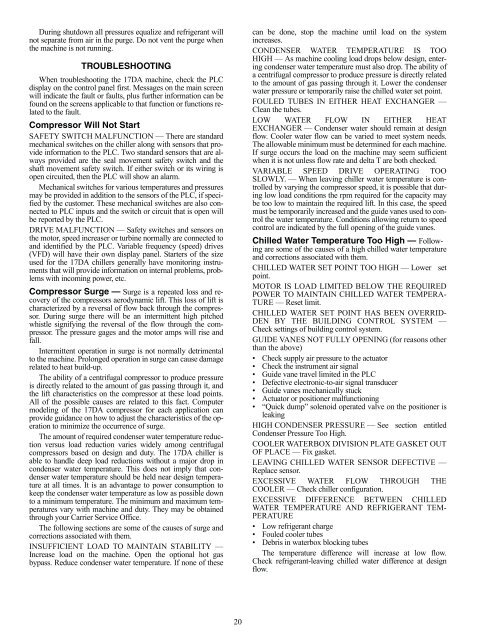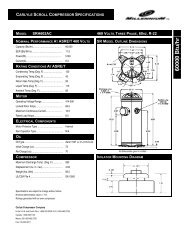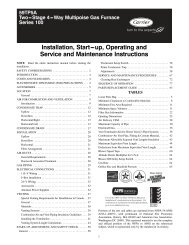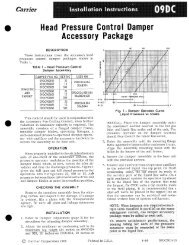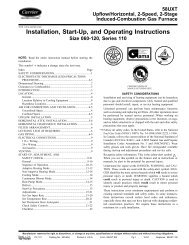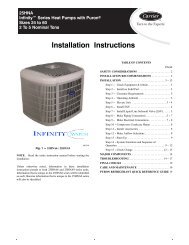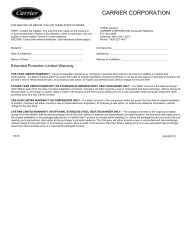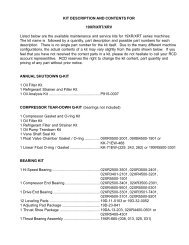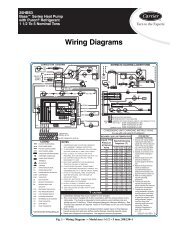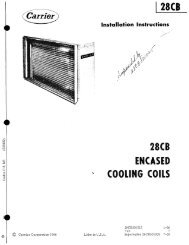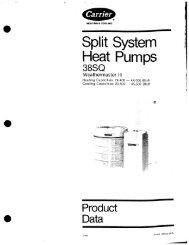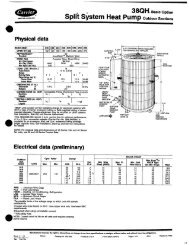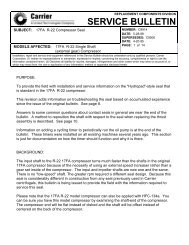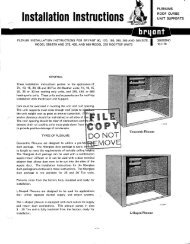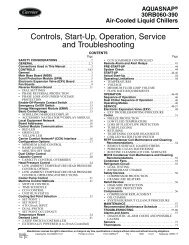Start-Up, Operation, and Maintenance Instructions - Carrier
Start-Up, Operation, and Maintenance Instructions - Carrier
Start-Up, Operation, and Maintenance Instructions - Carrier
You also want an ePaper? Increase the reach of your titles
YUMPU automatically turns print PDFs into web optimized ePapers that Google loves.
During shutdown all pressures equalize <strong>and</strong> refrigerant will<br />
not separate from air in the purge. Do not vent the purge when<br />
the machine is not running.<br />
TROUBLESHOOTING<br />
When troubleshooting the 17DA machine, check the PLC<br />
display on the control panel first. Messages on the main screen<br />
will indicate the fault or faults, plus further information can be<br />
found on the screens applicable to that function or functions related<br />
to the fault.<br />
Compressor Will Not <strong>Start</strong><br />
SAFETY SWITCH MALFUNCTION — There are st<strong>and</strong>ard<br />
mechanical switches on the chiller along with sensors that provide<br />
information to the PLC. Two st<strong>and</strong>ard sensors that are always<br />
provided are the seal movement safety switch <strong>and</strong> the<br />
shaft movement safety switch. If either switch or its wiring is<br />
open circuited, then the PLC will show an alarm.<br />
Mechanical switches for various temperatures <strong>and</strong> pressures<br />
may be provided in addition to the sensors of the PLC, if specified<br />
by the customer. These mechanical switches are also connected<br />
to PLC inputs <strong>and</strong> the switch or circuit that is open will<br />
be reported by the PLC.<br />
DRIVE MALFUNCTION — Safety switches <strong>and</strong> sensors on<br />
the motor, speed increaser or turbine normally are connected to<br />
<strong>and</strong> identified by the PLC. Variable frequency (speed) drives<br />
(VFD) will have their own display panel. <strong>Start</strong>ers of the size<br />
used for the 17DA chillers generally have monitoring instruments<br />
that will provide information on internal problems, problems<br />
with incoming power, etc.<br />
Compressor Surge — Surge is a repeated loss <strong>and</strong> recovery<br />
of the compressors aerodynamic lift. This loss of lift is<br />
characterized by a reversal of flow back through the compressor.<br />
During surge there will be an intermittent high pitched<br />
whistle signifying the reversal of the flow through the compressor.<br />
The pressure gages <strong>and</strong> the motor amps will rise <strong>and</strong><br />
fall.<br />
Intermittent operation in surge is not normally detrimental<br />
to the machine. Prolonged operation in surge can cause damage<br />
related to heat build-up.<br />
The ability of a centrifugal compressor to produce pressure<br />
is directly related to the amount of gas passing through it, <strong>and</strong><br />
the lift characteristics on the compressor at these load points.<br />
All of the possible causes are related to this fact. Computer<br />
modeling of the 17DA compressor for each application can<br />
provide guidance on how to adjust the characteristics of the operation<br />
to minimize the occurrence of surge.<br />
The amount of required condenser water temperature reduction<br />
versus load reduction varies widely among centrifugal<br />
compressors based on design <strong>and</strong> duty. The 17DA chiller is<br />
able to h<strong>and</strong>le deep load reductions without a major drop in<br />
condenser water temperature. This does not imply that condenser<br />
water temperature should be held near design temperature<br />
at all times. It is an advantage to power consumption to<br />
keep the condenser water temperature as low as possible down<br />
to a minimum temperature. The minimum <strong>and</strong> maximum temperatures<br />
vary with machine <strong>and</strong> duty. They may be obtained<br />
through your <strong>Carrier</strong> Service Office.<br />
The following sections are some of the causes of surge <strong>and</strong><br />
corrections associated with them.<br />
INSUFFICIENT LOAD TO MAINTAIN STABILITY —<br />
Increase load on the machine. Open the optional hot gas<br />
bypass. Reduce condenser water temperature. If none of these<br />
20<br />
can be done, stop the machine until load on the system<br />
increases.<br />
CONDENSER WATER TEMPERATURE IS TOO<br />
HIGH — As machine cooling load drops below design, entering<br />
condenser water temperature must also drop. The ability of<br />
a centrifugal compressor to produce pressure is directly related<br />
to the amount of gas passing through it. Lower the condenser<br />
water pressure or temporarily raise the chilled water set point.<br />
FOULED TUBES IN EITHER HEAT EXCHANGER —<br />
Clean the tubes.<br />
LOW WATER FLOW IN EITHER HEAT<br />
EXCHANGER — Condenser water should remain at design<br />
flow. Cooler water flow can be varied to meet system needs.<br />
The allowable minimum must be determined for each machine.<br />
If surge occurs the load on the machine may seem sufficient<br />
when it is not unless flow rate <strong>and</strong> delta T are both checked.<br />
VARIABLE SPEED DRIVE OPERATING TOO<br />
SLOWLY. — When leaving chiller water temperature is controlled<br />
by varying the compressor speed, it is possible that during<br />
low load conditions the rpm required for the capacity may<br />
be too low to maintain the required lift. In this case, the speed<br />
must be temporarily increased <strong>and</strong> the guide vanes used to control<br />
the water temperature. Conditions allowing return to speed<br />
control are indicated by the full opening of the guide vanes.<br />
Chilled Water Temperature Too High — Following<br />
are some of the causes of a high chilled water temperature<br />
<strong>and</strong> corrections associated with them.<br />
CHILLED WATER SET POINT TOO HIGH — Lower set<br />
point.<br />
MOTOR IS LOAD LIMITED BELOW THE REQUIRED<br />
POWER TO MAINTAIN CHILLED WATER TEMPERA-<br />
TURE — Reset limit.<br />
CHILLED WATER SET POINT HAS BEEN OVERRID-<br />
DEN BY THE BUILDING CONTROL SYSTEM —<br />
Check settings of building control system.<br />
GUIDE VANES NOT FULLY OPENING (for reasons other<br />
than the above)<br />
• Check supply air pressure to the actuator<br />
• Check the instrument air signal<br />
• Guide vane travel limited in the PLC<br />
• Defective electronic-to-air signal transducer<br />
• Guide vanes mechanically stuck<br />
• Actuator or positioner malfunctioning<br />
• “Quick dump” solenoid operated valve on the positioner is<br />
leaking<br />
HIGH CONDENSER PRESSURE — See section entitled<br />
Condenser Pressure Too High.<br />
COOLER WATERBOX DIVISION PLATE GASKET OUT<br />
OF PLACE — Fix gasket.<br />
LEAVING CHILLED WATER SENSOR DEFECTIVE —<br />
Replace sensor.<br />
EXCESSIVE WATER FLOW THROUGH THE<br />
COOLER — Check chiller configuration.<br />
EXCESSIVE DIFFERENCE BETWEEN CHILLED<br />
WATER TEMPERATURE AND REFRIGERANT TEM-<br />
PERATURE<br />
• Low refrigerant charge<br />
• Fouled cooler tubes<br />
• Debris in waterbox blocking tubes<br />
The temperature difference will increase at low flow.<br />
Check refrigerant-leaving chilled water difference at design<br />
flow.


